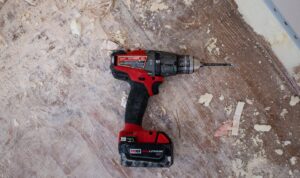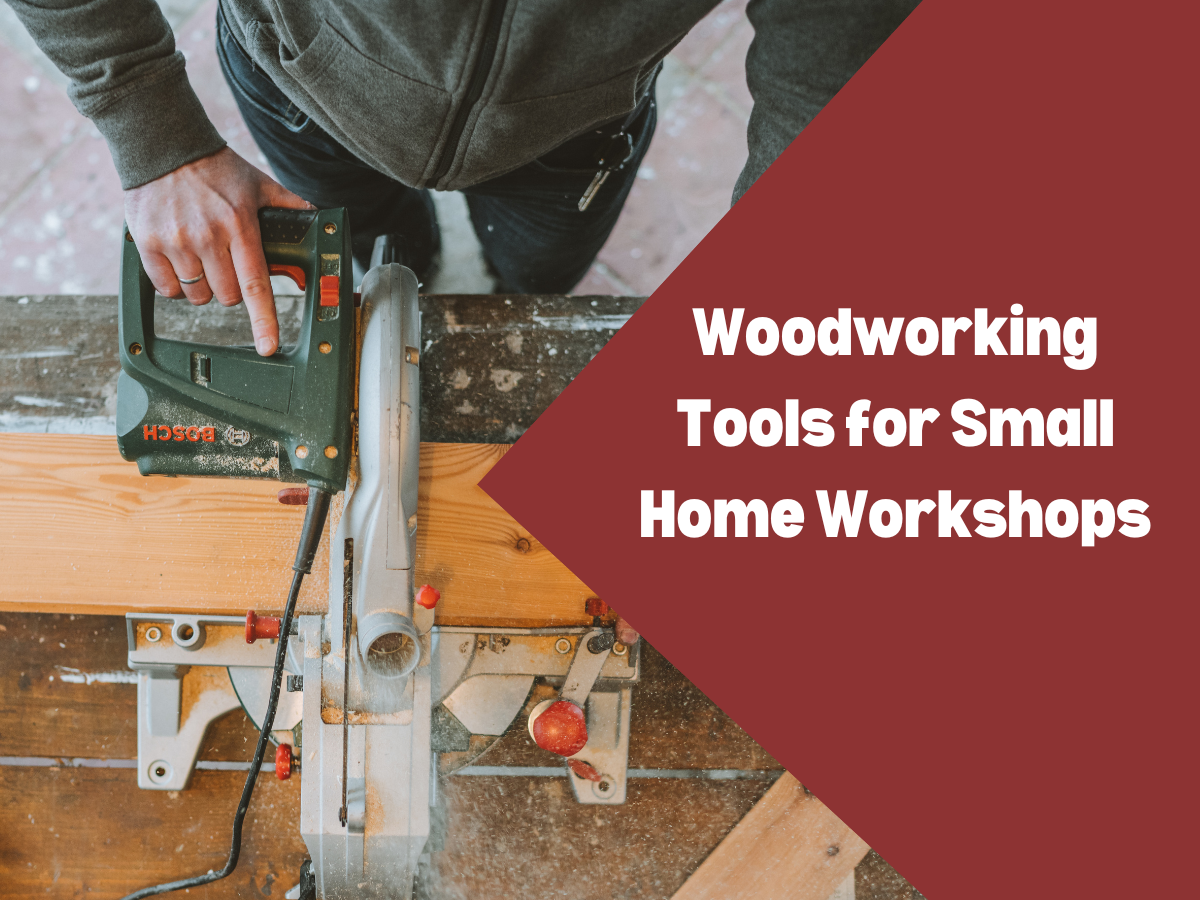Woodworking is a craft that has been enjoyed by generations. From building furniture to crafting unique items, woodworking can be a fulfilling hobby for anyone with an interest in working with their hands. With the rise in popularity of DIY projects and home workshops, woodworking has become an increasingly popular pastime for people looking to add a personal touch to their homes.
Why woodworking is a popular hobby for small home workshops
There are many reasons why woodworking is a popular hobby for small home workshops. Here are a few:
- Accessibility: With the rise of online tutorials and woodworking communities, it has become easier than ever to learn woodworking skills and techniques. This has made it more accessible for people to start working on woodworking projects from the comfort of their own homes.
- Customization: With woodworking, you have the ability to create custom pieces that fit your personal style and preferences. Whether you’re building a piece of furniture or a unique decorative item, woodworking allows you to make something truly one-of-a-kind.
- Relaxation: For many people, woodworking can be a relaxing and stress-free activity. The process of working with your hands and creating something from scratch can provide a welcome distraction from the stresses of everyday life.
Benefits of using the right woodworking tools
Having the right tools is essential for any woodworking project. Here are some of the benefits of using the right woodworking tools:
- Precision: The right tools can help you achieve a higher level of precision in your woodworking. Whether it’s a saw or a drill, having the right tool for the job can make all the difference in the final result.
- Safety: Using the right tools can also help you stay safe while working on your woodworking projects. This includes protective equipment like safety goggles, as well as tools designed to prevent accidents, like a table saw with safety features.
- Efficiency: Finally, having the right tools can also make your woodworking projects more efficient. With the right tools, you can work faster and more effectively, allowing you to complete your projects in less time.
In conclusion, woodworking is a great hobby for anyone looking to explore their creativity and work with their hands. With the right tools and resources, it’s easy to get started and create beautiful, unique pieces that you can be proud of.
Table Saws

When it comes to woodworking, having a reliable table saw is essential for any small home workshop. In this section, we’ll discuss the features you should look for when choosing a table saw and highlight some of the top models on the market for small home workshops.
Table Saw Features and How to Choose the Right One
Table saws come in a variety of sizes and with different features. Here are a few things to keep in mind when choosing a table saw:
- Blade Size: The blade size is an important factor, as it will determine the maximum depth of cut. For most small home workshops, a 10-inch blade is sufficient.
- Fence System: A quality fence system is essential for precision cutting. Look for a fence system that is easy to adjust and locks securely in place.
- Dust Collection: Woodworking can be a messy activity, which is why dust collection is important. Look for a table saw with a built-in dust collection system or one that is compatible with an external system.
- Power: Depending on the type of projects you’ll be working on, you’ll need a table saw with sufficient power. Look for a saw with a motor that is at least 1.5-2 horsepower.
Top Table Saw Models for Small Home Workshops
| Model | Blade Size | Fence System | Dust Collection | Power |
|---|---|---|---|---|
| SawStop PCS175-TGP236 | 10 inches | T-Glide Fence System | Compatible with external system | 1.75 horsepower |
| DEWALT DWE7491RS | 10 inches | Rack and Pinion Fence System | Built-in system | 15 amps |
| SKILSAW SPT99-11 | 10 inches | Self-Aligning Rip Fence | Compatible with external system | 4.0 horsepower |
These models are all great options for small home workshops, offering a combination of precision, power, and efficiency. By keeping these features in mind when choosing a table saw, you’re sure to find the right one for your woodworking projects.
Band Saws

If you’re a woodworker, you know that a band saw is an essential tool in any small home workshop. In this section, we’ll discuss the features you should look for when choosing a band saw and highlight some of the top models on the market for small home workshops.
Band Saw Features and How to Choose the Right One
Band saws come in different sizes and with different features. Here are some things you should keep in mind when choosing a band saw:
- Throat Size: The throat size determines the maximum width of cut. For most small home workshops, a 14-inch band saw is adequate.
- Blade Size: Blade size determines the maximum depth of cut. Consider what type of projects you’ll be working on when choosing a blade size.
- Table Size: Having a table that tilts and can be adjusted for height is essential for precision cutting.
- Motor Power: A more powerful motor means you’ll be able to work with thicker wood and make smoother cuts. Consider getting a band saw with at least 1-2 horsepower.
Top Band Saw Models for Small Home Workshops
| Model | Throat Size | Blade Size | Table Size | Motor Power |
|---|---|---|---|---|
| Grizzly G0555LX | 14 inches | 93.5 inches | 14 x 14 inches | 1 horsepower |
| JET JWBS-14DXPRO | 14 inches | 105 inches | 15 x 15 inches | 1.25 horsepower |
| Rikon 10-305 | 10 inches | 70.5 inches | 13.75 x 12.5 inches | .33 horsepower |
These models are great options for small home workshops, offering a combination of power, precision, and affordability. Keep these features in mind when selecting the right band saw for your woodworking projects.
Jointers
Are you a woodworker in need of a jointer to help you create perfectly flat and straight edges on your boards? In this section, we’ll discuss the features you should look for when choosing a jointer and highlight some of the top models on the market for small home workshops.
Jointer Features and How to Choose the Right One
Jointers come in different sizes and with different features. Here are some things you should keep in mind when choosing a jointer:
- Cutterhead Size: A larger cutterhead size means more cuts per inch and a smoother finish. Consider getting a jointer with at least a 6-inch cutterhead.
- Table Length: Longer tables can better handle longer boards without causing dips in the middle. Consider a jointer with a minimum table length of 40 inches.
- Cutterhead Speed: Faster cutterhead speeds result in a smoother finish. Consider a jointer with a cutterhead speed of at least 6,000 RPM.
- Fence Adjustability: The fence should be able to tilt and adjust easily for precision work. Consider a jointer with a fence that can tilt up to 45 degrees.
Top Jointer Models for Small Home Workshops
| Model | Cutterhead Size | Table Length | Cutterhead Speed | Fence Adjustability |
|---|---|---|---|---|
| Grizzly G0725 | 6 inches | 46 inches | 10,000 RPM | 45 degrees |
| Jet JJP-8BT | 8 inches | 44 inches | 6,000 RPM | 45 degrees |
| Cutech 40160H-CT | 6 inches | 42 inches | 10,000 RPM | 45 degrees |
These models offer a combination of power, precision, and affordability for small home workshops. Keep these features in mind when selecting the right jointer for your woodworking projects.
Planers
If you’re a woodworker, you know that a planer can help you smooth rough, uneven boards and give them a consistent thickness. In this section, we’ll discuss the features you should consider when choosing a planer and highlight some of the top models on the market for small home workshops.
Planer Features and How to Choose the Right One
When shopping for a planer, there are a few important features to keep in mind:
- Cutterhead: The cutterhead is the part of the machine that actually removes material from your boards. A larger cutterhead will make more cuts per inch and give you a smoother finish.
- Cutting Depth: The cutting depth determines how much material the planer can remove with each pass. Consider getting a planer that can remove at least 1/8 inch in one pass.
- Feed Rate: The feed rate controls how quickly the board moves through the planer. Faster feed rates can save time but may not always produce the best results.
- Dust Collection: Planers can create a lot of sawdust, so it’s important to choose one with effective dust collection to keep your workspace clean.
Top Planer Models for Small Home Workshops
| Model | Cutterhead Size | Cutting Depth | Feed Rate | Dust Collection |
|---|---|---|---|---|
| DeWalt DW735X | 13 inches | 1/8 inch | 30 feet per minute | 2.5-inch port |
| Rikon 25-130H | 13 inches | 1/8 inch | 23 feet per minute | 4-inch port |
| Jet JWP-13BT | 13 inches | 1/8 inch | 26 feet per minute | 2.5-inch port |
These models offer a good combination of power, precision, and affordability for small home workshops. Keep these features in mind when selecting the right planer for your woodworking projects.
Sanders

Image: istockphoto
If you’re into woodworking, chances are you’ll need a sander at some point to smooth out rough surfaces, remove old finishes, or prepare surfaces for painting. In this section, we’ll discuss the features you should consider when choosing a sander and highlight some of the top models on the market for small home workshops.
Sander Features and How to Choose the Right One
When shopping for a sander, there are several key features to keep in mind:
- Sanding Surface: Sanders come in different sizes, ranging from small handheld models to large stationary ones. Consider the size of the project you’ll be working on and choose a sander with a large enough sanding area.
- Type of Sander: There are different types of sanders for specific applications. Belt sanders are great for removing large amounts of material quickly, while orbital sanders are better for finishing work on delicate surfaces.
- Dust Collection: Sanding creates a lot of dust, so it’s important to choose a sander with effective dust collection to keep your workspace clean.
- Vibration: Vibration can cause fatigue and discomfort during prolonged use. Look for a sander with low vibration levels to reduce the risk of injury and increase comfort.
Top Sander Models for Small Home Workshops
Below are some of the top sander models suitable for small home workshops that offer a good balance of power, precision, and affordability:
| Model | Type | Sanding Surface | Dust Collection | Vibration Level |
|---|---|---|---|---|
| Makita BO5041K | Random Orbital Sander | 5 inches | Efficient Dust Collection System | Low |
| DeWalt DWE6423K | Random Orbital Sander | 5 inches | 80% dust collection efficiency | Low |
| Bosch ROS20VSC | Random Orbital Sander | 5 inches | Filter with micro-filter system | Low to moderate |
| WEN 6502T | Belt Disc Sander | 4 x 36 inches (belt) and 6 inches (disc) | 2.5-inch dust port for effective dust collection | Low |
Keep these features in mind when choosing the right sander for your woodworking projects. These models offer great performance, durability, and value for the home workshop.
Drills

Whether you’re an advanced DIYer or a novice looking to start your first project, a good drill is a must-have tool in any home workshop. With so many options on the market, it can be overwhelming to choose the right one. In this section, we’ll discuss the features you should consider when choosing a drill and highlight some of the top models for small home workshops.
Drill Features and How to Choose the Right One
When shopping for a drill, here are some features to keep in mind:
- Type of Drill: There are two main types of drills: corded and cordless. Corded drills offer unlimited power, while cordless drills offer convenience and portability.
- Chuck Size: The chuck is the part of the drill that holds the bit. Look for a drill with a chuck size that fits the bits you plan to use.
- Speed: Some drills have only one speed, while others offer variable speeds. Consider the types of materials you’ll be drilling into and choose a drill with appropriate speed options.
- Battery Life: If you opt for a cordless drill, pay attention to the battery life. Look for models with long-lasting batteries that can hold a charge for extended periods of time.
- Grip: Look for a drill with a comfortable grip, especially if you plan to use it for prolonged periods of time.
Top Drill Models for Small Home Workshops
Here are some top drill models perfect for small home workshops:
| Model | Type | Chuck Size | Speed Options | Battery Life |
|---|---|---|---|---|
| Black+Decker LDX120C | Cordless Drill/Driver | 3/8 inch | Variable speeds up to 650 RPM | Up to 20 volts, 1.5 Ah |
| DeWalt DCD771C2 | Cordless Drill/Driver | 1/2 inch | Two-speed transmission (0-450 and 0-1,500 RPM) | Up to 20 volts, 1.3 Ah |
| Makita DS4012 Spade Handle Drill | Corded Drill | 1/2 inch | Variable speed control (0-600 RPM) | N/A |
| Skil 6445-04 Hammer Drill | Corded Drill | 1/2 inch | Variable speed trigger (0-3,000 RPM) | N/A |
These drill models offer great performance, versatility, and value for the home workshop. Take note of the key features we’ve covered and choose the right drill that suits your woodworking needs.
Routers
Are you planning to dive into the world of woodworking? One of the essential tools you must have in your small home workshop is a router. It cuts, shapes, and hollows wood, making it an indispensable tool for carpentry and woodworking enthusiasts. With many router models and features to choose from, it can be a daunting task to find the right one. In this section, we will help you discover some of the top router models for small home workshops and features to consider when choosing a router.
Router Features and How to Choose the Right One
When selecting a router, here are some features to keep in mind:
- Type of Router: There are two types of routers: Fixed and plunge. Fixed routers allow you to adjust the depth of the cut before switching on. Plunge routers plunge straight into the material and allow you to adjust the depth of cut while the machine is already running.
- Size: Consider the size of the router compared to the size of the projects you’ll be working on.
- Speed: Look for a router with variable speed controls. Adjustments to speed help accommodate the type of wood and depth of cut needed. A wide speed range makes a router versatile and useful for a range of projects.
- Power: Choose a router with at least two horsepower. The power rating determines how well the router can handle tough materials or larger bits.
- Dust Collection: Find a router with a dust collection port that connects to a vacuum cleaner or dust extractor. Reducing dust improves visibility, accuracy, and safety.
Top Router Models for Small Home Workshops
If you’re looking for a reliable and versatile router, here are some top models to consider:
| Model | Type | Size | Speed Range | Power | Dust Collection Port |
|---|---|---|---|---|---|
| DeWalt DWP611PK | Fixed/Plunge Router | Compact, palm-size | Variable speed up to 27,000 RPM | 1.25 horsepower | Yes |
| Bosch 1617EVSPK | Fixed/Plunge Router | Mid-size | Variable speed up to 25,000 RPM | 2.25 horsepower | Yes |
| Makita RT0701CX7 | Fixed/Plunge Router | Compact, palm-size | Variable speed up to 30,000RPM | 1.25 horsepower | Yes |
| Ryobi P601 | Palm Router | Compact, palm-size | Variable speed up to 29,000 RPM | 1.5 horsepower | No |
These router models offer high performance, precision, and ease of use to cater to your woodworking needs. Familiarize yourself with these features to make an informed decision when selecting the right router for your small home workshop.
Routers
Do you intend to participate in the field of woodworking in the near future? You absolutely need to have a router in your home workshop, as it is one of the most important instruments you can have. As a result of its ability to hollow out, shape, and cut wood, it is an important instrument for those who are passionate about carpentry and woodworking.
When there are so many different router models and features to pick from, it can be a challenging endeavour to select the one that best suits your needs. When it comes to selecting a router, there are a number of qualities that should be taken into consideration, and in this area, we will present you with some of the best router models for small home workshops.
Router Features and How to Choose the Right One
When selecting a router, here are some features to keep in mind:
- Type of Router: There are two types of routers: Fixed and plunge. Fixed routers allow you to adjust the depth of the cut before switching on. Plunge routers plunge straight into the material and allow you to adjust the depth of cut while the machine is already running.
- Size: Consider the size of the router compared to the size of the projects you’ll be working on.
- Speed: Look for a router with variable speed controls. Adjustments to speed help accommodate the type of wood and depth of cut needed. A wide speed range makes a router versatile and useful for a range of projects.
- Power: Choose a router with at least two horsepower. The power rating determines how well the router can handle tough materials or larger bits.
- Dust Collection: Find a router with a dust collection port that connects to a vacuum cleaner or dust extractor. Reducing dust improves visibility, accuracy, and safety.
Top Router Models for Small Home Workshops
If you’re looking for a reliable and versatile router, here are some top models to consider:
| Model | Type | Size | Speed Range | Power | Dust Collection Port |
|---|---|---|---|---|---|
| DeWalt DWP611PK | Fixed/Plunge Router | Compact, palm-size | Variable speed up to 27,000 RPM | 1.25 horsepower | Yes |
| Bosch 1617EVSPK | Fixed/Plunge Router | Mid-size | Variable speed up to 25,000 RPM | 2.25 horsepower | Yes |
| Makita RT0701CX7 | Fixed/Plunge Router | Compact, palm-size | Variable speed up to 30,000RPM | 1.25 horsepower | Yes |
| Ryobi P601 | Palm Router | Compact, palm-size | Variable speed up to 29,000 RPM | 1.5 horsepower | No |
These router models offer high performance, precision, and ease of use to cater to your woodworking needs. Familiarize yourself with these features to make an informed decision when selecting the right router for your small home workshop.
Summary of the Top Woodworking Tools for Small Home Workshops
In summary, the top woodworking tools for small home workshops include:
- Circular saws for straight cuts
- Jigsaw for cutting curves and irregular shapes
- Miter saws for precision angle cuts
- Random orbital sander for smoothing surfaces
- Drills for making holes and screwing screws
- Router for cutting, shaping, and hollowing wood
Tips and Tricks to Maximize Your Woodworking Potential
Here are some tips and tricks to get the most out of your woodworking projects:
- Measure twice, cut once
- Invest in quality materials and tools
- Practice safety measures, such as wearing protective equipment and keeping work areas clean and well-lit
- Use the right tool for the job
- Join a woodworking community to learn new techniques and get inspiration
Conclusion
These top woodworking tools and tips can help you create beautiful and functional pieces in your small home workshop. Remember to choose the right tools for your projects, practice safety measures, and invest in quality materials and tools to enhance your woodworking potential.

I’m James Brown, the founder and editor of DIYINUSE.COM. I have over 15 years of hands-on woodworking and DIY experience that I share through tips and project inspiration on my website. When I’m not working on home improvement projects or creating content for the site, I enjoy spending time outdoors hiking and fishing. I’m always looking to expand my creativity and DIY skills by learning new techniques.
